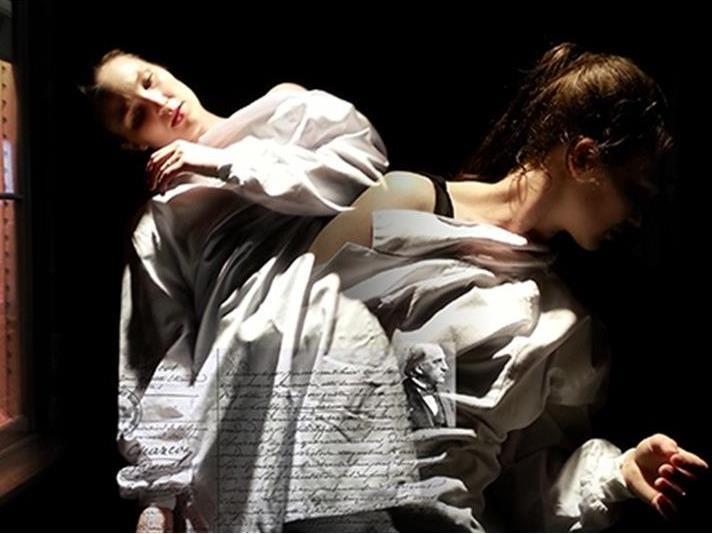The old adage goes that you should never work with children, animals, or firearms. In Living Room Theatre’s (LRT) new performance installation, children and animals play a central role in evoking the world of hysteria. Presented in association with the Sydney Environment Institute and Sydney University’s Macleay Museum and Veterinary Science faculty, LRT’s She Only Barks at Night is an eerie and unsettling evening, though perhaps not always as its creators intended.
Drawing on accounts of female hysteria from the 19th century and the treatments developed by Jean-Martin Charcot, She Only Barks at Night takes us deep within the corridors of the veterinary science building to destabilise our preconceptions and make us more susceptible to dreams and fragmented visions. The production begins in a round house normally intended for horses, its high wooden walls and freshly-laid hay warm on an otherwise cold night. A woman lies on the ground, dreaming; she tries to stand, before she is wheeled away.
Four girls burst into the yard, chattering animatedly, while their chaperone follows holding a taxidermied cat (I’m still at a loss as to its significance). Despite this sequence’s tenuous claims to historical veracity, it serves as a loose framework for LRT to create their piece around. We are then taken up several flights of stairs to a dissection lab, where a woman stands naked on a table while a doctor delivers a short lecture on the nature of hysteria and ‘the wandering womb’. Behind them, two other women stand on tables, caught in their own space, while to the side, a butcher and a surgeon cut meat, and the doctor prepares a taxidermied skin for display. A woman activates a shower and is drenched, splashing in the half-dark. So far so good. But as we descend out of the building and into the more subjective realms of experience and dreams, the production starts to unravel.
It’s not so much a case of too much material to include, but rather too much time being given to the exploration of each idea – much more time than is necessary. Scenes are over-extended and feel gratuitous and self-indulgent after their point is made in an image, sometimes in mere seconds. We stumble across a party in the corridor of an asylum, but are never made to feel part of it. Instead, we watch as one girl stumbles over a line of chairs and another tries to walk whilst swaddled in bubble-wrap. Importantly, the historical context to the piece is crucial, and a knowledge of it will help to make sense of a lot of what happens, especially in the first couple of scenes. Rather than share a brief introduction to the ideas at the start of the night, we are left to fend for ourselves; one sentence in the production’s publicity blurb is not enough grounding for the piece to make sense.
Part of the problem in She Only Barks at Night also lies in the blocking as much as in the context, in the way we are encouraged to participate (or not). Many scenes are blocked in a way that is not conducive to an audience’s presence – action happens in corridors and around corners; while we stand on the opposite side of the wooden cabinets. In site-specific immersive theatre like this, it is the actors’ job to encourage the audience to participate in a safe and effective way; if action is blocked around corners, then we should be urged to follow it rather than stand back, unsure of whether we should indeed follow. The four girls who burst into the round house at the beginning serve as shepherds of sorts, but at the same time they are also a part of the action and disappear from the ‘stage’ at times. As for the last scene in the museum, action should be blocked with the audience in mind – where should we stand, where should we look, what should we do? With no guidance or shepherding, we are free to stand and look wherever we want while the action happens in a far corner of the museum.
There is no real sense of an ending, just a whimpering out of the action. It was only as three women disappeared behind a cabinet that the audience decided of its own accord to see what was happening at the front of the floor, whereupon the evening concluded. In a production like this – especially in a production like this – the ending should be clear, should be built up to; should be climactic (pardon the pun).
The performers – actors, dancers, practitioners, and medical professionals alike – are reasonably strong, even if some characters do seem completely incongruous to the intention. Special mention is due to the music, performed live on a double-bass, trumpet, and found objects, by Clayton Thomas and Shota Matsumura. Despite the sparse instrumentation, they opened up an unsettling and elegantly haunting sonic dimension which enlivened some of the slower moments.
Contrary to LRT’s statement on their website, I don’t think this production will ‘change the way [we] see the built environment, museum curation and mental health in the [21st] century’. There are some good ideas here, except they are presented in a gratuitous and self-indulgent way, buried beneath ample amounts of superfluous material which, after a while, seems like flogging a (proverbial) dead cat.
I’m still not sure what the horse was all about.
Rating: 2 out of 5 stars
She Only Barks at Night
Director: Michelle St Anne
Lighting designer: Matt Osborne
Sound artist: Julia Reidy
Costume: Lian Loke
Milliner: Rosie Boylan
Horse Trainer: Kate Fenner
Choreographer: Imogen Cranna
Performers: Imogen Cranna, Cloé Fournier, Lian Loke, Maddy Wilson, Michelle St Anne, with Gavin Burland, Lance Proctor; also featuring Allegra, Amy, Molly & Rhea from Burwood Girls High and Harry the horse
With Clayton Thomas on Double Bass & objects and Shota Matsumura on Trumpet & objects
Vet School Roundhouse to Macleay Museum and all in between, University of Sydney
livingroomtheatre.org
27–31 May 2015





